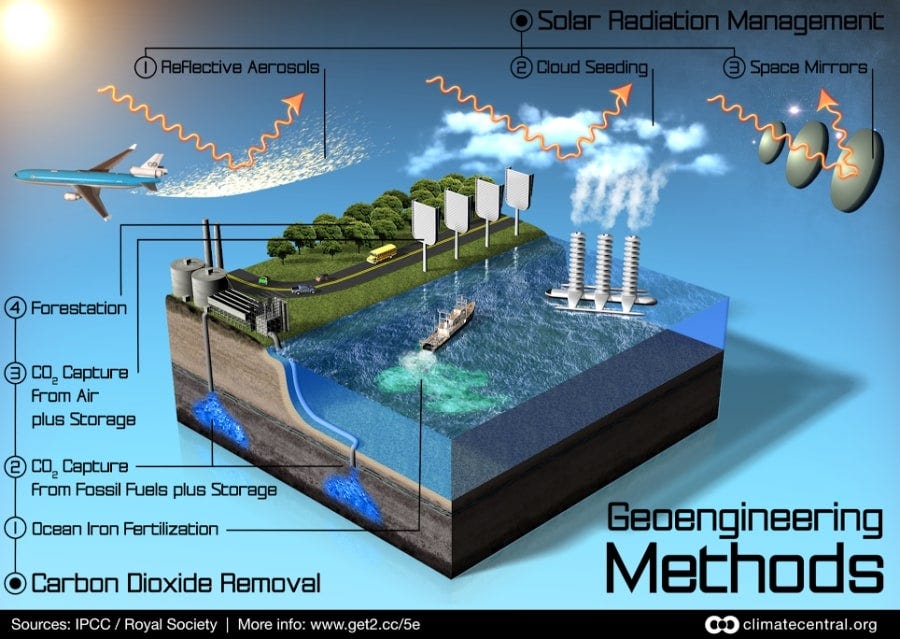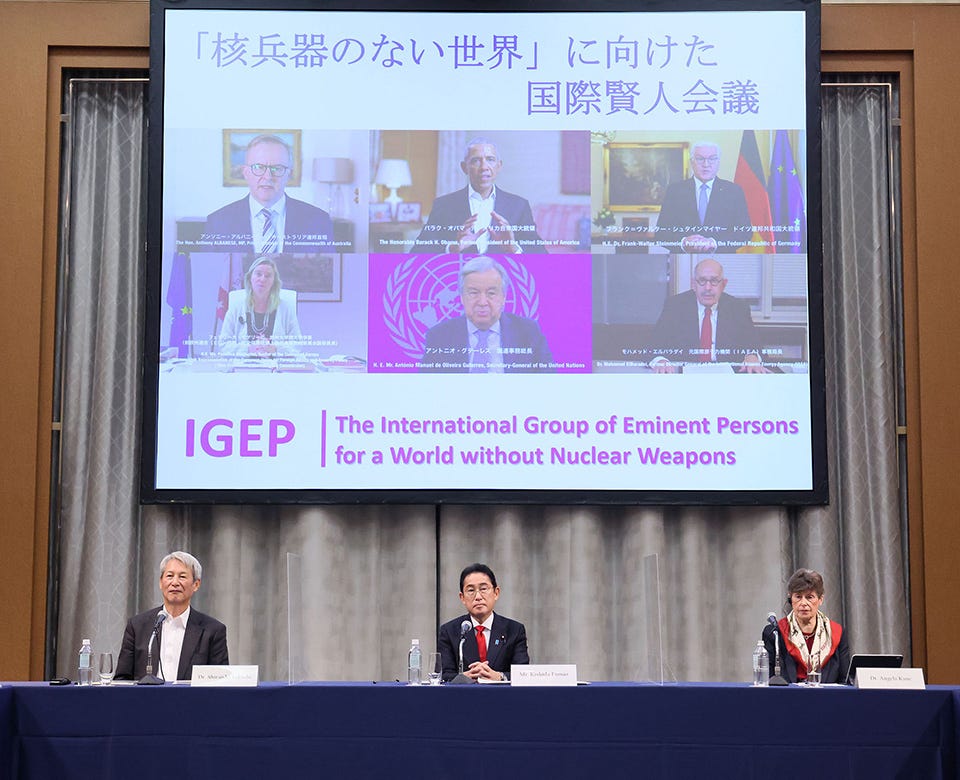Global Shield Briefing (10 April 2025)
Navigating polycrisis, governing geoengineering, and setting a path for nuclear risk reduction – and a new opportunity to join the Global Shield team.
The latest policy, research and news on global catastrophic risk (GCR).
Sometimes, we need to take a step back. Look at, nay, stare down existential and catastrophic risk with a bit more distance. Like David sizing up his giant opponent before slinging his shot.
Fortunately, two upcoming books might help. In Existential Hope, Dr SJ Beard flips the concept of avoiding existential threats to focusing on building a world that maximizes meaning and flourishing. In Goliath’s Curse, Dr Luke Kemp takes a macrohistory lens on societal collapse to look at how global, swift and irreversible civilizational collapse could occur in the future.
But what policymaker has time to read these days? And even if they do, how much impact could it have? Well, it wouldn’t be the first time that the book-length treatment of a serious topic ultimately, and unexpectedly, changed the course of history.
After reading John Barry’s 2004 book on the 1918 Spanish flu pandemic, The Great Influenza, George W. Bush directed the development of a National Strategy for Pandemic Influenza. [“Look, this happens every 100 years,” he told his homeland security adviser, “We need a national strategy.”] How prescient that looks now.
Shortly before the Cuban Missile Crisis, John F. Kennedy read The Guns of August on the outbreak of World War I and the dangers of miscalculation. [“I am not going to follow a course which will allow anyone to write a comparable book about this time,” he reportedly told confidants, just two days before Nikita Khrushchev agreed to remove Soviet missiles from Cuba.] How fortuitous that must have seemed.
Or take the impact of Harriet Beecher Stowe’s 1852 book, Uncle Tom's Cabin, on the abolitionist movement and the American Civil War. When President Lincoln met with Stowe, he supposedly told her, “So you are the little woman who wrote the book that started this great war.” How daunting that would have felt.
Navigating polycrisis

The Accelerator for Systemic Risk Assessment (ASRA) interviewed Lorenzo Benini, Sustainability Transitions Expert at the European Environment Agency, on governing systemic risk. He states that “the biggest governance challenge in dealing with the “triple planetary crisis” [climate change, biodiversity loss and pollution] is that our current institutions and decision-making processes are poorly equipped to handle systemic risks, which are inherently uncertain and complex.”
The European Commission has published a toolkit for policymaking institutions to run a workshop on polycrisis awareness, understanding and action. In one activity, participants can identify potential policy responses and solutions, consider the agency of policymakers to address core drivers, and develop novel ideas for impactful solutions and partnerships.
Policy comment: Traditional policy establishments, which organize policy areas and their budgets by discrete government agencies, struggle to cope with systemic risk. Bureaucratic resistance, political dynamics, information-sharing challenges, and knowledge gaps across government mean that complex policy problems, like global catastrophic risk, will be difficult to address proactively. Integrated policymaking is an early step. Such approaches view and tackle multiple problem sets together, such as environment and health, or climate and security, or disasters, access to resources and societal resilience. Resourced effectively, these help break down institutional siloes and provide a more holistic treatment of risk. However, even these approaches are beyond the ability of many governments. An even more preliminary step to treating system risk is early warnings and strategic foresight. Before a crisis occurs or escalates, warning senior policymakers quickly can help steer an integrated and cross-cutting policy effort. By systematically monitoring the triggers and indicators of potential crises, policymakers can be better equipped to take preventive measures, mobilize a coordinated response, and alleviate the harmful consequences.
Governing geoengineering

An Israel-based, US-incorporated startup called Stardust is developing proprietary technology that would help block sun rays from reaching Earth as a way to reduce the climate impact of greenhouse gas emissions. According to a report in Undark, the company has been secretive about its work. Stardust’s former climate governance consultant posted his report about the company on Linkedin, calling for it to increase its transparency, engagement and communication with the public and external stakeholders.
An article in Science looks at the need for geoengineering projects to be more transparent with the public. Many researchers are skeptical about public engagement and consultation, fearing blowback from potentially misinformed individuals. One researcher stated that “some scientists believe engagement isn’t necessary because they feel the importance of the research should override public concerns.”
A recent study on solar geoengineering estimates that “the mortality benefits of reducing temperatures outweigh risks from air pollution and from ozone loss by 13 times for our central estimates, with a 61% probability the benefits exceed the risks.” It goes on to note that “Uncertainty remains significant”.
Policy comment: The gap in global and national geoengineering governance means that corporations and scientists are taking action without policy guardrails or public input. As it stands, the unintended side effects of geoengineering are very unclear and its consequences remain ungoverned. No country has a geoengineering policy. The only relevant international treaty, the Environmental Modification Convention, is old, weak and limited to hostile weather warfare. And there is very little government-led research into the topic – a new US$75m effort by the UK’s innovation agency is the largest publicly acknowledged initiative. Significantly more research is needed into the ethical, environmental, legal, humanitarian, economic, geopolitical, and security aspects of geoengineering. Poor governance and risk awareness around geoengineering is also emblematic of other types of technology risk, like from AI and synthetic biology. Governments could implement a systematic and transparent process to evaluate and categorize existing or emerging technologies based on their potential to pose GCR. A formal technology risk assessment process would determine the potential for misuse or unintended consequences, or how the technology exacerbates other threats or system vulnerabilities.
Setting a path for nuclear risk reduction

The International Group of Eminent Persons for a World Without Nuclear Weapons (IGEP) met for the sixth and final time over March 30-31. Sponsored by the Government of Japan, the IGEP is a track-2 style multilateral dialogue composed of nuclear experts and former senior diplomats from both nuclear-weapon states and non-nuclear-weapon states. It was established to discuss a path towards a world without nuclear weapons. The group has developed a set of urgent actions for countries to consider across nuclear conflict prevention, non-proliferation and the 2026 Non-Proliferation Treaty review conference.
Policy comment: The actions outlined by IGEP present a comprehensive and reasonable path for nuclear risk reduction. It calls for sustained strategic dialogues, crisis prevention, human oversight on nuclear command and control, restraint around cyber attacks on nuclear facilities, and counter-proliferation. However, global catastrophic risk – while the underlying motivator for reducing nuclear risk – does not feature explicitly in these types of dialogues or government action plans. The equation on GCR from nuclear weapons is different from, and more complex than, Cold War-era risk calculus. Tripolar strategic dynamics, the impact of AI and cyber, the rising capabilities of so-called ‘rogue’ states, and relationships of nuclear states with allies and partners, is complicating and exacerbating 21st century nuclear risk. The main example of GCR considerations entering these multilateral efforts is, as the IGEP plan refers, a recent UN General Assembly resolution that establishes an independent Scientific Panel on the Effects of Nuclear War, which will be able to officially consider and communicate nuclear winter scenarios. Member States should contribute productively to this study. The final report is due in 2027.
A new opportunity with Global Shield
The Global Shield team is growing again! The Global Growth and Development Manager will lead our organization’s growth into new countries. As an organization that seeks to reduce global catastrophic risk, we believe that all countries can make a difference. And we believe that Global Shield can make a difference in those countries. The role is to identify promising countries for expansion, build relationships with partners in those countries, and establish a presence that can effectively execute on our mission. Please share with your networks, or consider applying yourself.
This briefing is a product of Global Shield, an international advocacy organization dedicated to reducing global catastrophic risk of all hazards. With each briefing, we aim to build the most knowledgeable audience in the world when it comes to reducing global catastrophic risk. We want to show that action is not only needed, it’s possible. Help us build this community of motivated individuals, researchers, advocates and policymakers by sharing this briefing with your networks.



